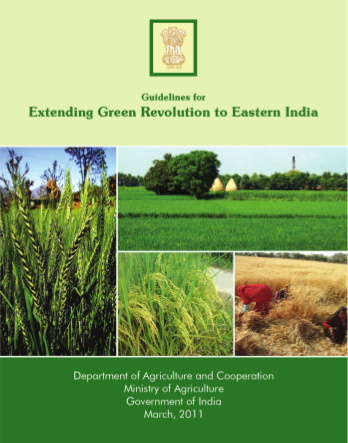 The states of Assam, Bihar, eastern U.P, Chattisgarh, Jharkhand, Bengal, Orissa were allocated extra funds in the last year for this purpose. This year (2011-12) too, the Union Budget has allocated additional Rs.400 crore for the same purpose. The money will be utilised according to a plan created by these states. The plan is to address the main constraints impeding the growth of agriculture. The short and medium term plan focuses on water management, efficient power and other input utilisation. Also the creation and maintenance of agricultural assets like wells is also looked into.
The states of Assam, Bihar, eastern U.P, Chattisgarh, Jharkhand, Bengal, Orissa were allocated extra funds in the last year for this purpose. This year (2011-12) too, the Union Budget has allocated additional Rs.400 crore for the same purpose. The money will be utilised according to a plan created by these states. The plan is to address the main constraints impeding the growth of agriculture. The short and medium term plan focuses on water management, efficient power and other input utilisation. Also the creation and maintenance of agricultural assets like wells is also looked into.
The planning was done so that non-National Food Security Mission (NFSM) districts are mostly chosen. These constitute 54 % of the total districts (97 out of 183). Also, clusters of villages comprising of 1000 hectares land were made in most cases. Such clusters would expedite execution, monitoring and create visible impacts.
Further the program is split into 4 categories -
Block demonstration of rice and wheat-
An amount of Rs 204.2 crores is proposed to be spent on block demonstrations in the rainfed uplands, rainfed low lands, and irrigated rice regions. The objective is to improve the seed replacement rate, promote line sowing along with promotion of plant nutrient and plant protection technologies. It is proposed that hybrid rice technologies be promoted in 40 units of the 10,000 hectares.
There will be a similar effort to promote wheat in Bihar, Uttar Pradesh and West Bengal with emphasis on use of zero till seed drill. Rs 48.8 crores is proposed for 122 demonstration sites in these states.
Asset building activities -
These are split into water management and promotion of farm implements. In the case of water management focus will be on construction of wells with 100% financial assistance. While for promoting farm implements zero till seed drills, pump-sets will be promoted. Subsidies will be provided for the procurement of these implements.
Site specific activities for enhancing agriculture production and productivity -
These include other crop development, construction of water channels, power etc.
Monitoring -
Rs 4 crore is allocated for monitoring. There will be a three tier monitoring structure in the form of committees at the centre, state and district level. At the centre the monitoring committee will be under the chairmanship of the secretary (A&C), while the state level committee will have the secretary/joint secretary of the department of agriculture as the chairman. The district agriculture officer will head the district monitoring committee.
A table provides the budgetary allocation for each of the states.
The deliverables at the end of this programme are -
- Demonstration of production technologies for wheat and rice in different agroclimatic zones conducted in 4 lakh hectares.
- Reduction in difference between the actual and potential productivity of rice by almost 50%
- Creation of assets including water management structures like 29500 shallow tube wells, 9000 dug well/ bore well; 42000 pump-sets, zero till seed drills and drum seeders to ensure sustained agricultural productivity.
- Promotion of line sowing, input use efficiency and scientific crop management for increased crop production.
The annexures give the time-lines for the implementation of the programme, different financial and physical targets for each state. There is also a breakdown of the constraints being faced by each state along with the strategies adopted to overcome these hurdles. The constraints range from low seed productivity and floods to acidic soils and low seed replacement ratio. The strategies adopted include improving soil health through bio-fertilisers, creation of rainwater harvesting structures, use of water sprinklers etc.
This document gives insights into the programme for improving agriculture in the eastern part of India. It would be of interest to those who are involved in agronomy, agriculture or in the history of agriculture in modern India.
Download the report here:





 Guidelines_for_extending_green_revolution_to_eastern_India_Department_for_Agriculture_and_Cooperation__2011_.pdf
Guidelines_for_extending_green_revolution_to_eastern_India_Department_for_Agriculture_and_Cooperation__2011_.pdf







